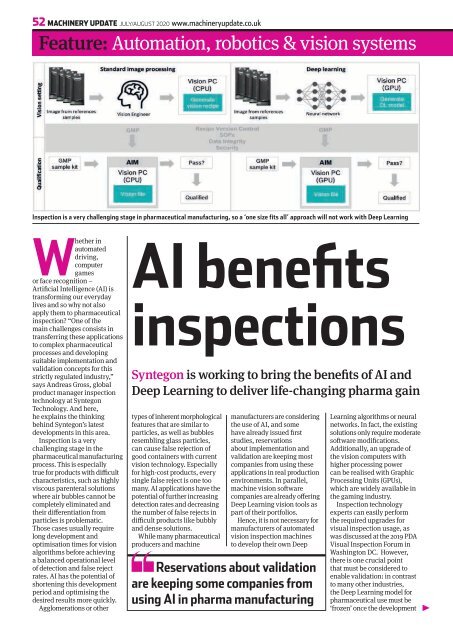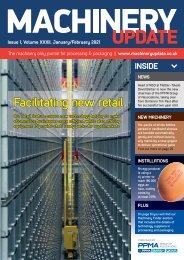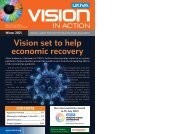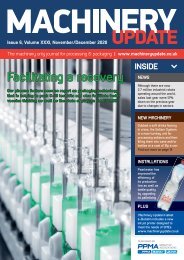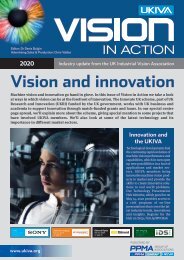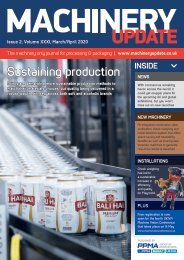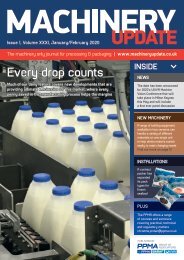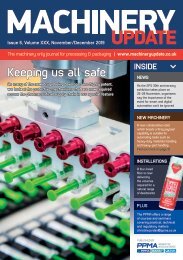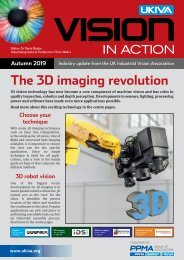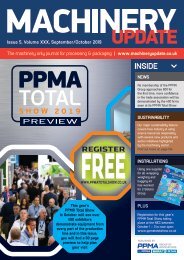Machinery Update July / August 2020
The July / August 2020 issue of Machinery Update.
The July / August 2020 issue of Machinery Update.
- No tags were found...
Create successful ePaper yourself
Turn your PDF publications into a flip-book with our unique Google optimized e-Paper software.
52 MACHINERY UPDATE JULY/AUGUST <strong>2020</strong> www.machineryupdate.co.uk<br />
Feature: Automation, robotics & vision systems<br />
Inspection is a very challenging stage in pharmaceutical manufacturing, so a ‘one size fits all’ approach will not work with Deep Learning<br />
Whether in<br />
automated<br />
driving,<br />
computer<br />
games<br />
or face recognition –<br />
Artificial Intelligence (AI) is<br />
transforming our everyday<br />
lives and so why not also<br />
apply them to pharmaceutical<br />
inspection? “One of the<br />
main challenges consists in<br />
transferring these applications<br />
to complex pharmaceutical<br />
processes and developing<br />
suitable implementation and<br />
validation concepts for this<br />
strictly regulated industry,”<br />
says Andreas Gross, global<br />
product manager inspection<br />
technology at Syntegon<br />
Technology. And here,<br />
he explains the thinking<br />
behind Syntegon’s latest<br />
developments in this area.<br />
Inspection is a very<br />
challenging stage in the<br />
pharmaceutical manufacturing<br />
process. This is especially<br />
true for products with difficult<br />
characteristics, such as highly<br />
viscous parenteral solutions<br />
where air bubbles cannot be<br />
completely eliminated and<br />
their differentiation from<br />
particles is problematic.<br />
Those cases usually require<br />
long development and<br />
optimisation times for vision<br />
algorithms before achieving<br />
a balanced operational level<br />
of detection and false reject<br />
rates. AI has the potential of<br />
shortening this development<br />
period and optimising the<br />
desired results more quickly.<br />
Agglomerations or other<br />
AI benefits<br />
inspections<br />
Syntegon is working to bring the benefits of AI and<br />
Deep Learning to deliver life-changing pharma gain<br />
types of inherent morphological<br />
features that are similar to<br />
particles, as well as bubbles<br />
resembling glass particles,<br />
can cause false rejection of<br />
good containers with current<br />
vision technology. Especially<br />
for high-cost products, every<br />
single false reject is one too<br />
many. AI applications have the<br />
potential of further increasing<br />
detection rates and decreasing<br />
the number of false rejects in<br />
difficult products like bubbly<br />
and dense solutions.<br />
While many pharmaceutical<br />
producers and machine<br />
manufacturers are considering<br />
the use of AI, and some<br />
have already issued first<br />
studies, reservations<br />
about implementation and<br />
validation are keeping most<br />
companies from using these<br />
applications in real production<br />
environments. In parallel,<br />
machine vision software<br />
companies are already offering<br />
Deep Learning vision tools as<br />
part of their portfolios.<br />
Hence, it is not necessary for<br />
manufacturers of automated<br />
vision inspection machines<br />
to develop their own Deep<br />
Reservations about validation<br />
are keeping some companies from<br />
using AI in pharma manufacturing<br />
Learning algorithms or neural<br />
networks. In fact, the existing<br />
solutions only require moderate<br />
software modifications.<br />
Additionally, an upgrade of<br />
the vision computers with<br />
higher processing power<br />
can be realised with Graphic<br />
Processing Units (GPUs),<br />
which are widely available in<br />
the gaming industry.<br />
Inspection technology<br />
experts can easily perform<br />
the required upgrades for<br />
visual inspection usage, as<br />
was discussed at the 2019 PDA<br />
Visual Inspection Forum in<br />
Washington DC. However,<br />
there is one crucial point<br />
that must be considered to<br />
enable validation: in contrast<br />
to many other industries,<br />
the Deep Learning model for<br />
pharmaceutical use must be<br />
‘frozen’ once the development<br />
▸


